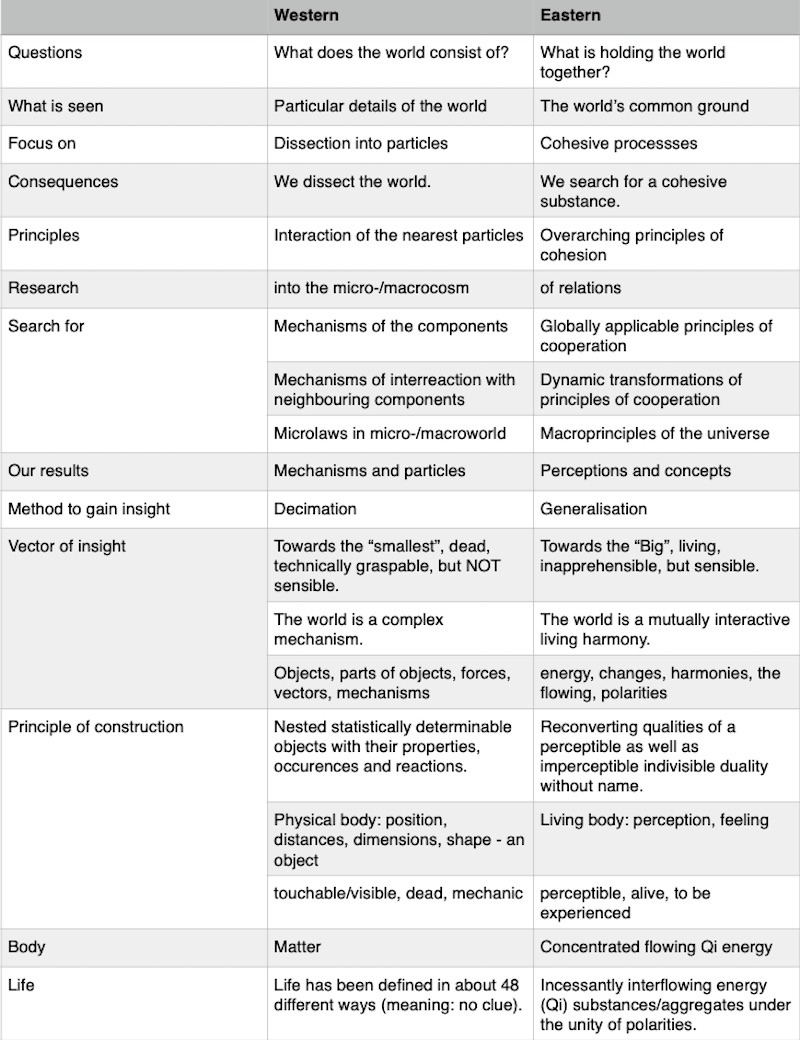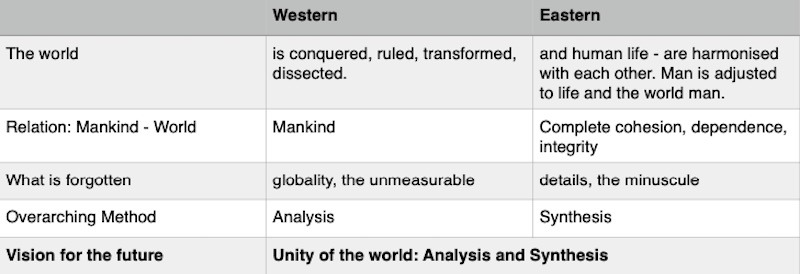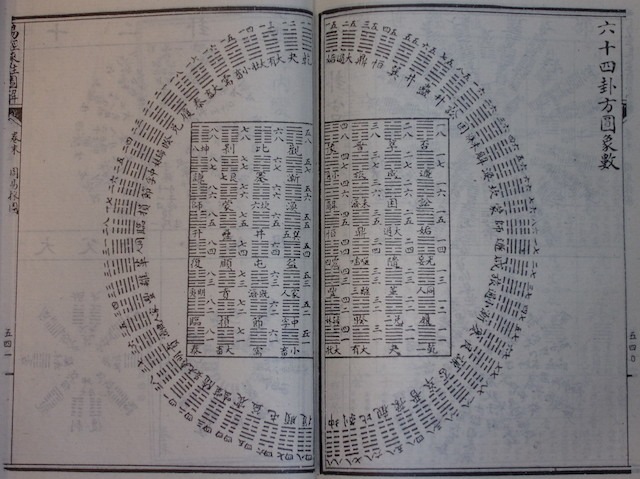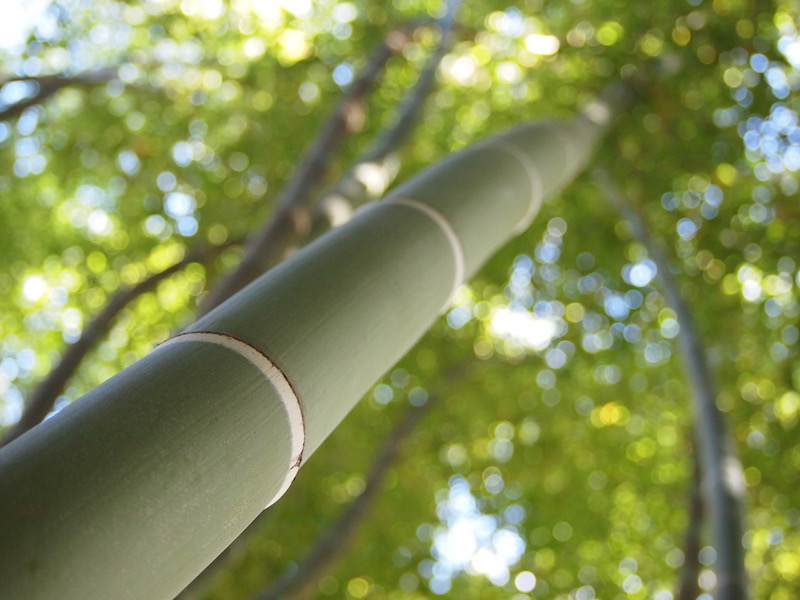About Eastern and Western Thought: Origin and Consequences
Western Thought: 500BC-460AD – Leucippus, Democritus
Everything is made up out of “atomoi”.
Leucippus‘ and Democritus‘ teachings.
The world = empty space and matter.
From there, a scientific way of thought developed, which is “ordinary” for our Western world, our culture and our age.
Questions
What does the world consist of?
Out of which components is the world built?
What is behind it (deeper, smaller, more detailed)?
Search for
Components and mechanisms which hold these components together
Continuous verifiable forces
Research
by dissecting, atomising, deepening, specifying
We dissect the world, searching for micro laws (mechanisms), but:
Only those which are ALWAYS repeatable Only those which are ALWAYS verifiable with technical means
Consequences
Thinking
in parts, fragments → dissecting;
in mechanisms → simplifying.
Specialisation of areas of knowledge, professions, etc.

Eastern Thought: 30-20 centuries BC
[The period of 22nd-8th century BC is referred to as Bronze Age in Central Europe.]
Everything is made up from Qi (气/氣) energy and its movement. Teachings of the “I Ching – The Book of Changes” (易經/易经) about the energy movement between polarities. These polarities themselves are interdependent and merge into each other. This energy in its original form is not measurable, research is exploring reproducible and “random” incidents. This point of view is summarised in the Taiji symbol (☯️太極/ 太极). The philosophy of Laozi (老子)and Confucius(孔夫子)fuelled these ideas and this way of thought.
Questions
What is holding the world together?
What is responsible for the changes?
How do changes move?
What moves?
Why does it move?
Search for
Processes, links, long-term changes
invisible forces in the changes
Research
by observing, testing the changes, perceiving.
Consequences
Thinking in relations, commonalities, connections.
Contrasting comparison of Western and Eastern Thought


The Western and the Chinese Way of Thinking – in Words
“In Europe, the body-mind dualism began its triumph, when Democritus (about 460-370 BC) determined the official philosophy one-sidedly following the general concept of the tactile and visible body. After that, it was Plato (about 427-348 BC) who championed dualism by postulating independent ideas apart from these bodies.” (Yin und Yang [original publication in German], Gudula Linck, 2001) – a kind of separation between body (matter) and spirit.
The origin of the Book of Changes lies somewhere around the first half of the Zhou dynasty (about 1100-256 BC) and builds the basic structure of thought of Chinese people. One tried to understand this world as a whole. The notions of Dao, Yin and Yang are commonly known to us. But behind them stands a widely different approach to that what we call our own.

At this point, our ways are separating widely. Based on experience, we developed analysis and all its connected mechanisms and the Chinese developed synthesis. Form this moment on, we walked on different philosophical paths and – naturally – pursued different goals. And accomplished different things. We analyse(d) the world and “dissected” it into all its single pieces, seeing the details of matter, processes and energies, developed formulas and discovered the laws of the material world. We proceeded to depth and detail. We studied the microcosm. With scientific principles, we are successful in science and technic. At the same time, we went to the “smallest”, the dead, and knew in the end, that the world and the universe is a gigantic and very complex mechanism.
Simultaneously, the Chinese walked on the path of synthesis. They searched for connecting substances in world affairs, human life and developments of states. They studied the macro laws of the universe and the integration of humans into subordinate structures. They searched for relations, for general and linking elements. The Chinese were interested in perceptions, concepts, synergies and interrelations.
They were interested in things that are not tactile and visible, but sensible. And in the end, they came to the “biggest”, the connected, the living and knew, that the world is an interactive, living, balance-seeking harmony of all elements.
These different approaches lead to different strategies.
The Western civilising strategy is segmentation, domination, conquering and remodelling of the living environment. The world is seen as consisting of nested, comprehensible objects with their properties, occurrences, reactions and actions.
The Eastern civilising strategy is the adaption of humans to the world and the world to the humans, an attempt of mutual harmonisation. In this context, the world is made up of reconverting qualities of a perceptible as well as imperceptible indivisible duality without name.
Author: Igor Galkin
Contact the author: i.a.galkin@posteo.de, (languages: German, Russian, English). Igor Galkin lives in Dresden, Germany.
Images: Taiji Forum
#MartialMonday #PhilosophicalFriday #WellnessWednesday 8 Brocades applications Baguazhang beginner calligraphy Cheng Man Ching Chinese Internal Arts Dantian Faye Yip Gabi Kannenberg Glossary Grandmaster health qigong Huang Tsui-Chuan International Push Hands Meeting Interview Ken van Sickle Martial Applications Nils Klug Push Hands Qi qigong Qigong Exercises qigong healing review stepping sword tai chi Tai Chi 8 movements Tai Chi Aspects Tai Chi at home Tai Chi online Tai Chi Studio tai chi tips taijiquan Tina Faulkner Elders Video Wang Ning webdifinition welovepushhands William C. C. Chen Yangsheng

